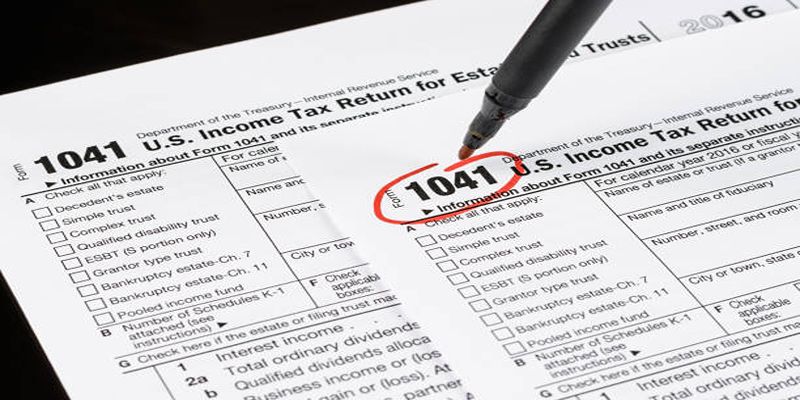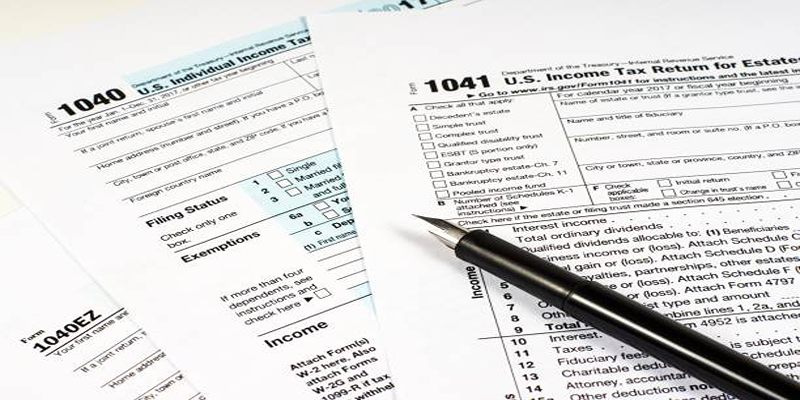Understanding Form 1041: A Complete Guide for Estates and Trusts
Oct 05, 2024 By Georgia Vincent
Navigating the complexities of tax forms can be challenging, especially when it comes to estates and trusts. Form 1041, formally known as the U.S. Income Tax Return for Estates and Trusts, is a vital document demanding meticulous attention. It's essential for reporting the gains, income, deductions, and losses of estates and trusts, playing a crucial role in maintaining proper tax compliance for a deceased's estate or a trusts financial activities. Whether you are an executor, trustee, or beneficiary, understanding the fundamentals of Form 1041 is pivotal for managing these responsibilities effectively. This guide aims to provide a thorough comprehension of Form 1041, simplifying its components and clarifying the filing process to ensure you navigate it with confidence.
What is Form 1041?

Form 1041 is an income tax return form specific to estates and trusts. It was created by the Internal Revenue Service (IRS) to ensure that these entities are properly taxed on their income, gains, deductions, and losses. As mentioned earlier, it serves as a crucial tool for ensuring tax compliance and reporting of financial activities related to estates and trusts.
Who Needs to File Form 1041?
Not all estates or trusts need to file Form 1041. Generally, if an estate or trust has gross income of $600 or more in a tax year, then it must file Form 1041. Gross income includes interest earned on bank accounts, dividends from stocks, rental income, and any other type of income generated by the estate or trust. There are exceptions to this rule, such as when the estate or trust is claiming a deduction for distributions made to beneficiaries. Consult with a tax professional if you are unsure whether your estate or trust needs to file Form 1041.
When is Form 1041 Due?
Form 1041 is due on April 15th of each year, unless the entity has a fiscal tax year (a tax year that does not end on December 31st). In that case, it must be filed on the 15th day of the fourth month after the close of its tax year. For example, if an estate or trusts tax year ends on September 30th, the Form 1041 would be due on January 15th of the following year.
Components of Form 1041
Understanding the structure and components of Form 1041 is essential for accurate and efficient filing. Below is a detailed breakdown of the main sections of Form 1041:
1. Basic Information
This section requires general details about the estate or trust, including:
- Name of the estate or trust: Enter the legal name exactly as it appears on legal documents.
- Fiduciary's name and address: The fiduciary is the person or entity responsible for managing the estate or trust. Provide their full name and contact details.
- Employer Identification Number (EIN): This unique number is assigned by the IRS to identify the estate or trust.
- Date of the decedent's death (if applicable): If the form pertains to an estate, include the date of the deceased individuals passing.
2. Income
This section captures all income sources for the estate or trust:
- Interest income: Include interest earned from savings accounts, certificates of deposit, and other interest-bearing accounts.
- Dividends: Report dividends received on stocks and mutual funds.
- Capital gains or losses: Calculate gains or losses from the sale of estate or trust assets.
- Rents, royalties, partnerships, other estates and trusts: Account for income from real estate rentals, royalties, and distributive shares from partnerships or other estates and trusts.
- Business income: If the estate or trust operates a business, include the net profit or loss.
3. Deductions
Deductions reduce the gross income to arrive at the taxable income:
- Charitable contributions: Deduct contributions made to qualified charitable organizations.
- Interest expense: Include interest paid on loans or mortgages against estate or trust property.
- Taxes: Deduct state and local taxes paid.
- Fiduciary fees: Report fees paid to the fiduciary for managing the estate or trust.
- Administrative expenses: Include costs associated with managing and distributing the estate or trust, such as legal and accounting fees.
- Distributions to beneficiaries: Deduct amounts distributed to beneficiaries during the tax year.
4. Tax and Payments
This section determines the tax liability and credits:
- Tax calculation: Use the IRS tax tables or schedules to calculate the tax based on the taxable income.
- Credits: Report any tax credits that can be applied against the tax due, such as foreign tax credits.
- Payments: Include any estimated tax payments, federal income tax withheld, and any other payments applied against the tax owed.
By understanding and accurately completing these components, you ensure that Form 1041 is submitted correctly, reflecting the financial reality of the estate or trust, and complying with IRS obligations.
How to File Form 1041
Filing Form 1041 involves a series of steps to ensure accurate completion and timely submission. Here is a breakdown of how to file Form 1041:
- Gather Necessary Information: Before you start filling out Form 1041, collect all relevant documents and information. This includes financial statements, details of income earned, deductions, credits, and any distributions made to beneficiaries over the tax year.
- Fill Out the Preliminary Sections: Begin with the basic information required on the form, such as the name of the estate or trust, the fiduciary's name and address, the Employer Identification Number (EIN), and the date of the decedent's death, if applicable.
- Report Income: Enter the total income of the estate or trust. This encompasses various types of income such as interest, dividends, business income, or rental income. Each type of income is to be recorded in the specific sections designated for them on Form 1041.
- Calculate Deductions and Credits: Accurately report any deductions the estate or trust is eligible for. Common deductions include charitable donations, administrative expenses, and distributions to beneficiaries. Tax credits should also be accounted for to reduce the overall tax liability.
- Compute Taxable Income: Subtract the total deductions from the total income to determine the taxable income. Ensure all calculations are double-checked to avoid errors.
- Determine Tax Liability: Use the IRS tax tables or tax rate schedules to compute the tax due based on the taxable income calculated.
- Enter Payments and Other Taxes: Include any estimated tax payments already made, as well as any other applicable taxes, such as the Net Investment Income Tax, if relevant.
- Complete and Review the Return: Ensure that all parts of Form 1041 are filled out accurately. Review the information thoroughly for any mistakes or omissions.
- Sign and Date: The fiduciary (executor or trustee) must sign and date the form. If an accountant or tax preparer has assisted, their details and signature are also required.
- File the Form: Submit Form 1041 by mail or electronically to the IRS by the due date (April 15th for calendar year estates and trusts). Keep a copy of the filed form and all supporting documentation for your records.
By following these steps meticulously, you ensure that Form 1041 is filed correctly, reflecting the financial activities of the estate or trust accurately and in compliance with IRS regulations.
Consequences of Non-Compliance

Failure to file Form 1041 or incorrect filing can result in penalties and interest charges. The IRS may also conduct an audit to determine any discrepancies between the income reported on the form and that reported by beneficiaries on their individual tax returns. It is crucial to ensure accurate and timely filing of Form 1041 to avoid any potential consequences.
Conclusion
Form 1041 is a vital document for reporting the income, deductions, and tax liability of estates or trusts. By understanding its components and following the necessary steps for filing, you can accurately reflect the financial activities of the estate or trust and comply with IRS regulations. Failure to file or incorrect filing can have significant consequences, so it is crucial to pay close attention to detail and seek professional assistance if needed.
-
 Know-how Jan 06, 2024
Know-how Jan 06, 2024What You Need to Know About Roadside Assistance
Calling roadside assistance might be helpful if you run out of petrol or have a flat tire. Before you make a purchase, here are some things to think about.
-
 Investment May 19, 2024
Investment May 19, 2024Which One is the Best Financial App: Banktivity vs Quicken
Between Banktivity Vs. Quicken, Banktivity's budgeting is great for Mac users, whereas Quicken offers investment tracking and bill management.
-
 Investment Jan 06, 2024
Investment Jan 06, 2024What Is AA Power Of Attorney, What Role Does It Play, And How Do I Create One
The legal instrument known as a "power of attorney" (POA) designates one person as another's agent to carry out specified legal tasks. Consequently, an attorney-in-fact can act on their principal's behalf in court with a power of attorney. The principal and agent can agree on the agent's decision-making authority over the principal's property, money, investments, and medical care.
-
 Investment Feb 04, 2024
Investment Feb 04, 2024Can You Still Retire If You Don't Have Any Money Saved
To start saving for retirement is never too late. Your options will narrow as you age, owing to retirement and required minimum distributions. It's excellent news that most people have more free time than they think. You still have almost 30 years to take advantage of compound interest through tax-deferred retirement vehicles, even if you don't start saving until you're 35.
